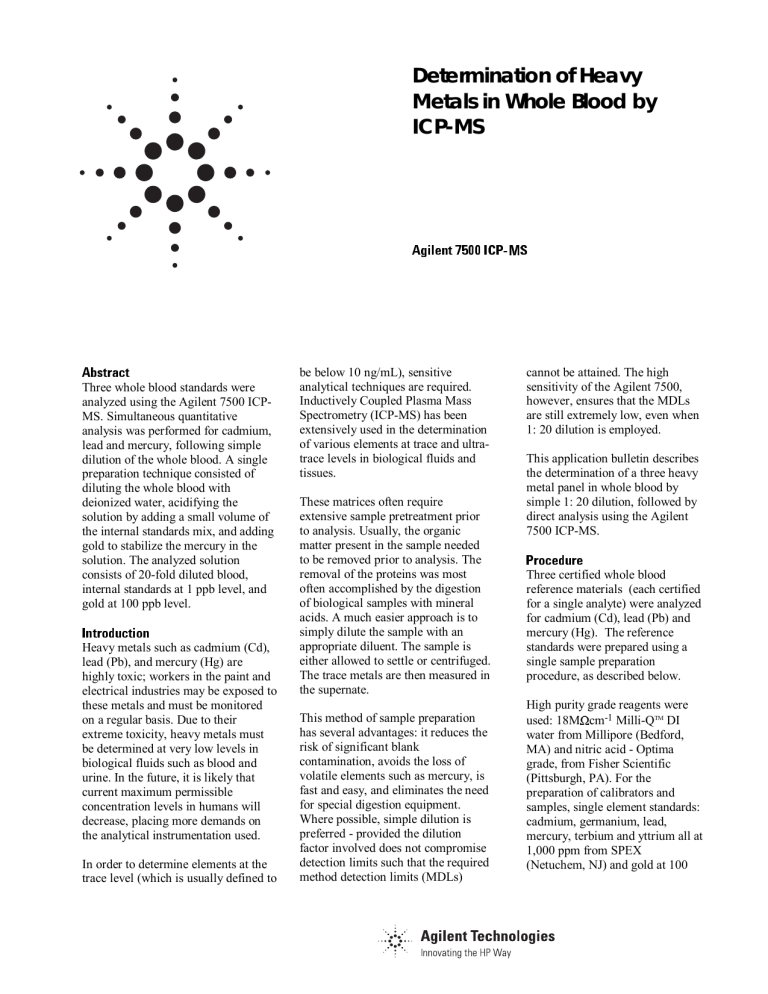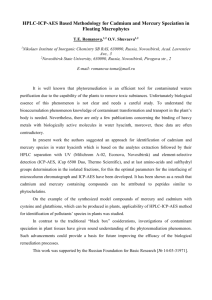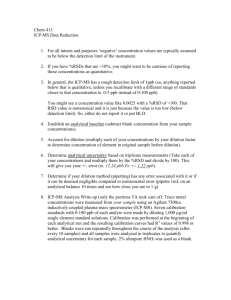Determination of Heavy Metals in Whole Blood by

Determination of Heavy
Metals in Whole Blood by
ICP-MS
$JLOHQW,&306
$EVWUDFW
Three whole blood standards were analyzed using the Agilent 7500 ICP-
MS. Simultaneous quantitative analysis was performed for cadmium, lead and mercury, following simple dilution of the whole blood. A single preparation technique consisted of diluting the whole blood with deionized water, acidifying the solution by adding a small volume of the internal standards mix, and adding gold to stabilize the mercury in the solution. The analyzed solution consists of 20-fold diluted blood, internal standards at 1 ppb level, and gold at 100 ppb level.
,QWURGXFWLRQ
Heavy metals such as cadmium (Cd), lead (Pb), and mercury (Hg) are highly toxic; workers in the paint and electrical industries may be exposed to these metals and must be monitored on a regular basis. Due to their extreme toxicity, heavy metals must be determined at very low levels in biological fluids such as blood and urine. In the future, it is likely that current maximum permissible concentration levels in humans will decrease, placing more demands on the analytical instrumentation used.
In order to determine elements at the trace level (which is usually defined to be below 10 ng/mL), sensitive analytical techniques are required.
Inductively Coupled Plasma Mass
Spectrometry (ICP-MS) has been extensively used in the determination of various elements at trace and ultratrace levels in biological fluids and tissues.
These matrices often require extensive sample pretreatment prior to analysis. Usually, the organic matter present in the sample needed to be removed prior to analysis. The removal of the proteins was most often accomplished by the digestion of biological samples with mineral acids. A much easier approach is to simply dilute the sample with an appropriate diluent. The sample is either allowed to settle or centrifuged.
The trace metals are then measured in the supernate.
This method of sample preparation has several advantages: it reduces the risk of significant blank contamination, avoids the loss of volatile elements such as mercury, is fast and easy, and eliminates the need for special digestion equipment.
Where possible, simple dilution is preferred - provided the dilution factor involved does not compromise detection limits such that the required method detection limits (MDLs) cannot be attained. The high sensitivity of the Agilent 7500, however, ensures that the MDLs are still extremely low, even when
1: 20 dilution is employed.
This application bulletin describes the determination of a three heavy metal panel in whole blood by simple 1: 20 dilution, followed by direct analysis using the Agilent
7500 ICP-MS.
3URFHGXUH
Three certified whole blood reference materials (each certified for a single analyte) were analyzed for cadmium (Cd), lead (Pb) and mercury (Hg). The reference standards were prepared using a single sample preparation procedure, as described below.
High purity grade reagents were used: 18M cm -1 Milli-Q TM DI water from Millipore (Bedford,
MA) and nitric acid - Optima grade, from Fisher Scientific
(Pittsburgh, PA). For the preparation of calibrators and samples, single element standards: cadmium, germanium, lead, mercury, terbium and yttrium all at
1,000 ppm from SPEX
(Netuchem, NJ) and gold at 100
ppm from SPEX (Netuchem, NJ) were used.
Working stock solution of Internal
Standard mix: germanium (Ge), yttrium (Y) and terbium (Tb) at the concentration of 1 ppm in 5% nitric acid was prepared from single element stock solutions. The use of bismuth as an internal standard is not recommended due to its presence in some medications.
9.48 mL of water was placed in a 10or 12-mL test tube. 0.5 mL of whole blood was added to it, followed by
0.01 mL of internal standard mix and
0.01 mL of gold. The described sequence of adding the appropriate solutions to the test tube assures the minimal precipitation of proteins. The supernate can be analyzed either following the short (1 minute) centrifugation of the sample, or after waiting at least 20 minutes to assure the settlement of the precipitate at the bottom of the test tube. If less than 0.5
mL of the whole blood is available, all volumes can be adjusted. The final dilution factor should be 20-fold, the final concentration of internal standards – 1 ppb, and the final concentration of gold: 100 ppb.
Note: Some coagulation can occur during acidification, due to natural variations in human blood. In severe cases, care must be taken to ensure that the nebulizer uptake tube does not become clogged.
Mercury is typically a difficult element to analyze in solution as it tends to adhere to the surfaces of the sample introduction system. In this case, a quartz spray chamber was used since spray chambers made from polymers such as PTFE and Ryton
TM tend to suffer more from mercury memory effects than quartz. In addition, the use of excess gold also helps in reducing memory effects.
The addition of gold to the samples, in which mercury is determined was pioneered by US Environmental
Protection Agency (US EPA)
1
and is successfully used by hundreds of commercial labs.
2SHUDWLQJDQG$FTXLVLWLRQ
3DUDPHWHUV
A standard Agilent 7500 (either
Agilent 7500a or Agilent 7500i) benchtop ICP-MS, fitted with a crossflow nebulizer and a quartz spray chamber was used throughout.
Operational parameters are given in
Table I. Acquisition parameters are listed in Table II.
Table I
Parameter
Argon Gas
Flow Rates
Plasma
Auxialiary
Carrier
RF Power
Sampling
Depth
Nebulizer
Spray
Chamber
Spray
Chamber
Temp.
Sample
Uptake
15.0
1.0
1.2
1350
6.7
0.4
Value
Cross-flow or
Babington
Double-pass, quartz
2
Units
L/min
L/min
L/min
W mm
°C mL/min
Table II
Analytes
Internal Standards
Additional Masses
114Cd, 202 Hg, 208Pb
72Ge, 89Y, 159Tb
206Pb, 207Pb
Number points per mass
Acquisition Times
3
Yttrium and
Terbium
Germanium
0.3 second per mass
0.3 second per mass
Cadmium
Mercury
0.99 second per mass
21 second per mass
Lead (all isotopes) 0.3 second per mass
Number of repetitions
Total acquisition time
Sample-to-sample time
3
76 seconds
< 4 minutes
$QDO\WLFDO3URWRFRO
The calibration standards
(calibrators) and samples (certified reference materials) were loaded into the autosampler. The Agilent
7500 peri-pump program software was set to increase sample uptake rate during wash cycles to reduce analysis time. All wash solutions contained gold at the concentration of 100 ppb. At the end of the run, the data can be automatically imported into a customized database. The autosampler’s capacity is up to 270 patient samples plus all necessary QA/QC solutions. If needed, the Agilent
7500 can shut down automatically at the end of the run.
5HVXOWV
Six-point calibration curves were created in aqueous solutions (1% nitric acid). The appropriate concentrations are listed in Table
III. The listed values are shown in ng/mL. Micrograms-per-liter
(ug/L) are preferred units for reporting trace elements in human body fluids and tissues (as specified in NCCLS Document
C38)
2
and nanograms-per-milliliter
(ng/mL) are acceptable equivalent units. Parts per billion (ppb), which are widely used as units in
ICP-MS measurements, are unacceptable units for biological fluids.
Table III
Standard 1
Standard 2
Standard 3
Standard 4
Standard 5
Standard 6
Cadmium ng/mL
(ppb)
0.00
Lead ng/mL
(ppb)
0.0
Mercury ng/mL
(ppb)
0.00
0.02
0.10
0.20
0.80
2.00
0.2
0.5
2.0
8.0
20.0
0.02
0.10
0.20
0.80
2.00
Three certified reference materials
(CRMs) from Le Centre de toxicologie du Quebec were analyzed. Each whole blood CRM was certified for a single element.
The following CRMs were used:
2
for the determination of cadmium – C-
97-11, for the determination of lead –
L-98-02, and for the determination of mercury – M-98-01. The quantitative results and the certified values are represented in Table IV.
Table IV
Analyte Measured ng/mL (ppb)
C-97-11
Cadmium
Lead
Mercury
3.15
0.97
15.9
Certified ng/mL
(ppb)
3.48 (2.25 - 4.50)
N/A
N/A
L-98-02
Cadmium
Lead
Mercury
M-98-01
Cadmium
Lead
Mercury
1.41
86.5
2.63
0.28
15.0
7.82
N/A
93.2 (62.2 - 124)
N/A
N/A
N/A
8.02 (5.42 - 10.6)
Instrument detection limits (IDLs) and method detection limits (MDLs) were calculated and are presented in Table
V.
Table V
Analyte
Cadmium
Lead
Mercury
IDL ng/mL (ppb)
0.00009
0.00027
0.0082
MDL ng/mL (ppb)
0.0018
0.005
0.16
Three sigma detection limits were calculated utilizing seven blank repetitions and calibration plots.
MDLs were then derived by applying the dilution factor from the sample preparation stage. The MDLs represent the detection limit obtained for the whole blood sample. As illustrated, the combination of the
Agilent 7500’s sensitivity and the use of simple dilution to avoid reagent blank contamination combines to provide an extremely sensitive technique for the measurement of heavy metals in whole blood.
&RQFOXVLRQ
The Agilent 7500 has been shown to be a fast and very sensitive tool for the multi-element analysis of heavy metals in whole blood. Three replicates of the sample were measured in less than one minute.
Less than 1 mL of the sample volume was consumed. The process of simply diluting the sample offers a very fast sample turnaround time compared to more conventional methods of sample preparation involving matrix removal. Sample capacity enables the operator to take advantage of the high sample throughput possible with this technique: the autosampler can be loaded with 270 samples, in addition to any standards, wash solutions and
QC check standards required. The superior sensitivity of the Agilent
7500 gives method detection limits at sub-ng/mL levels in the whole blood, enabling trace element determination at concentration levels not available from other techniques.
Multielemental capabilities of the
ICP-MS are not fully used, since with the same amount of sample and practically the same sample-tosample analysis time, the whole blood several other heavy metals (including thallium and arsenic) can be determined simultaneously with cadmium, lead and mercury.
5HIHUHQFHV
1
EPA Method 200.8 EMMC version,
Revision 5.4. EMSL Cincinnati OH
45268 - May 1994
2
NCCLS Document C38 C38-P ,
Control of Pre-Analytical Variation in
Trace Element Determinations;
Proposed Guideline (1994), ISBN 1-
56238-262-4.
This application bulletin demonstrates feasibility of concept. Additional development and/or validation may be required for routine use.
Printed 3/2001
Publication number 5988-0533EN
3







